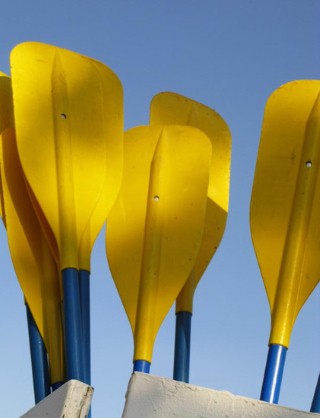 People often spend a lot of time deciding on the perfect kayak, and then drop the ball when it comes to getting the right paddle. Choosing the right kayak paddle is an important part of creating an enjoyable experience on the water. The paddle is more than just a stick with two wide ends. It is your engine.
People often spend a lot of time deciding on the perfect kayak, and then drop the ball when it comes to getting the right paddle. Choosing the right kayak paddle is an important part of creating an enjoyable experience on the water. The paddle is more than just a stick with two wide ends. It is your engine.
There are several issues to consider when picking a kayak paddle. How you will be using the paddle is one part of the equation. Some other things to consider are kayak size, the materials the paddles are made of and how heavy the paddle is. Blade design is also a feature new kayakers often overlook.
Types of Kayak Paddles
How you will use your kayak and will determine the style of paddle you need. Touring kayak paddles differ from a standup kayak paddle, a whitewater paddle and crossover paddle. A good touring paddle will have deep scoops in the blades that allow for maximum water movement and higher traveling speeds. If the kayak you use allows for standing, a long shaft and longer, thinner blades will let you direct and steer from an upright position.
Materials and Weight of Kayak Paddles
Anglers who use their kayaks to fish spend more time drifting than moving, and can use a heavier paddle. More weight can mean a sturdier piece, but will make the paddle harder to carry over a long trip. Touring and sporting kayakers will want a paddle that is durable and can stand up to the rigors of use, but not tire out their arms on long journeys. Paddle material choices are fiberglass, carbon fiber and plastic. The strength and durability as well as weight ascend in the same order with fiberglass being the strongest and also the heaviest type of paddle and plastic being lightest but also weakest. Carbon fiber is an excellent choice for touring and sporting kayakers.
Blade Shape
Kayak paddle blades are positioned in one of two ways. They can be feathered or non-feathered. The differences are easy to spot if you know what they are. Feathered blades are positioned at 45% angles when the shaft is held evenly between each hand. Non-feathered blades are straight. Feathering provides extra control and speed. They are better adapted to reduce wind resistance and are a top choice for sporting and touring. Non-feathered blades have a deeper, stronger connection to the water surface and allow quicker movements in tight areas like small streams or rivers. While it is largely a matter of choice, non-feathered blades can be a great choice for kayak fishermen.
Shaft Style
The kayak shaft is more than just a pole. It can be bent to provide better motion during the stroke. Poles are available as a single solid piece or two-piece styles. Anglers often prefer a two-piece that can be broken down easily while adrift and reassembled to travel when needed. Kayakers of all type can appreciate the convenience of a two-piece paddle as a reserve that is easily stored in a small compartment onboard for emergencies. Having an extra alleviates the worry of being caught “upstream without a paddle.”

